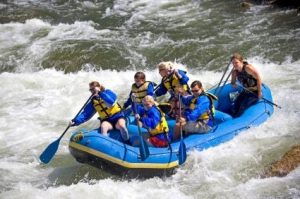Sonora, CA — PG&E and California State Parks warn water enthusiasts to take seriou precautions against cold temperatures and swift currents when in or near waterways this spring.
PG & E Spokesperson Brandi Ehlers says even with the below-normal snowfall, the spring snowmelt can still result in dangerous conditions for not only swimmers, but also hikers cooling off next to the shore. Lower water levels can also expose hazards or bring them closer to the surface.
Ehlers says, “You want to make sure you avoid diving into open water especially when you can’t see the bottom. You don’t always know whether it is a foot deep or two feet deep or 20 feet deep. You can hit your head on objects that are hidden just below the surface, but you can’t see them well enough.”
Here is PG&E’s list of water safety tips:
Know the Water:
- Sudden immersion in cold water can stimulate the “gasp reflex,” causing an involuntary inhalation of air or water. It can even trigger cardiac arrest, temporary paralysis, hypothermia and drowning. When faced with swift water, even the strongest swimmers may be easily overwhelmed.
- Cold water entering the ear canal can cause vertigo and disorientation. This may confuse swimmers, causing them to venture deeper into the water.
- Recreating in PG&E canals and flumes is strictly prohibited. Stay out of canals and flumes, which are very dangerous due to slippery sides and fast moving water.
- Lower lakes and rivers can expose hazards like rocks and trees, or make them closer to the surface.
Know your Limits:
- Swimming in open water is more difficult than in a swimming pool – people tire more quickly and can get into trouble.
- Cold water causes impairment leading to fatalities. It reduces body heat 25 to 30 times faster than air does at the same temperature.
- Many unseen obstacles can be lurking below the water’s surface. Swift water can make these obstacles even more treacherous. Guided trips for inexperienced paddlers are recommended.
Wear a Life Jacket:
· Conditions change quickly in open water and even the best swimmers can misjudge the water and their skills when boating or swimming. Wearing a life jacket can increase survival time.
- A life jacket can provide some thermal protection against the onset of hypothermia and keep you afloat until someone else can rescue you.
Parental Supervision:
- Actively supervise children in and around open bodies of water, giving them your undivided attention. Appoint a designated “water watcher,” taking turns with other adults.
- Teach children that swimming in open water is not the same as swimming in a pool: they need to be aware of uneven surfaces, river currents, ocean undertow and changing weather.
Know the Law:
- Every child under 13 must wear a Coast Guard-approved life jacket when on a moving vessel that is 26 feet or less in length.
- A Coast Guard-approved life jacket must be carried for each person on board a boat. This includes rigid or inflatable paddle craft.
- Every person on board a personal watercraft (popularly known as “jet skis”) and any person being towed behind a vessel must wear a Coast Guard-approved life jacket.
- It is against the law to operate a boat or water ski with a blood alcohol concentration (BAC) of 0.08 percent or more. You can be arrested even when your BAC is less than 0.08 percent if conditions are deemed unsafe.


